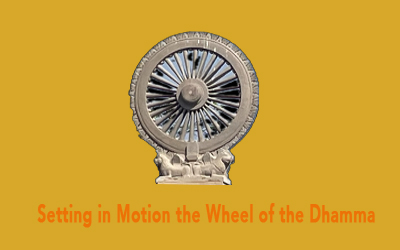The Four Noble Truths are the first sermon preached by Sakya Muni Buddha to the His five disciple namely Konadañña, Vappa, Bhaddiya, Mahānama and Assaji at the Deer Park, after He attained Enlightenment and realized the Truth, complete liberation and freedom from suffering.
The Buddha taught that entangling oneself in sensual indulgence, tormenting one’s body with harship and pain, these are ways a renunciant should not undertake, for stray from the path of enlightenment.
“Bhikkhus, these two extremes should not be followed by one who has gone forth into homelessness. What two? The pursuit of sensual happiness in sensual pleasures, which is low, vulgar, the way of worldlings, ignoble, unbeneficial; and the pursuit of self-mortification, which is painful, ignoble, unbeneficial. Without veering towards either of these extremes, the Tathagata has awakened to the middle way, which gives rise to vision, which gives rise to knowledge, which leads to peace, to direct knowledge, to enlightenment, to Nibbāna”.
The Four Noble Truths is known as The Middle Path (Majjhimā – Patipadā), which is known as:
I. The Noble Truth of suffering (Dukkha – Ariyasaccā)
“Now this, bhikkhus, is the noble truth of suffering: birth is suffering, aging is suffering, illness is suffering, death is suffering; union with what is displeasing is suffering; separation from what is pleasing is suffering; not to get what one wants is suffering; in brief, the five aggregates subject to clinging are suffering.”
II. The Noble Truth of the origin of suffering (Dukkha – Samudaya – Ariyasaccā)
“Now this, bhikkhus, is the noble truth of the origin of suffering: it is this craving which leads to renewed existence, accompanied by delight and lust, seeking delight here and there; that is, craving for sensual pleasures, craving for existence, craving for extermination”.
III. The Noble Truth of the cessation of suffering (Dukkha – Nirodha Ariyasaccā)
“Now this, bhikkhus, is the noble truth of the cessation of suffering: it is the remainderless fading away and cessation of that same craving, the giving up and relinquishing of it, freedom from it, nonreliance on it”.
VI. The Noble Truth of the Path leading to the cessation of suffering (Dukkha – Nirodha Gāminī – Patipadā – Ariyasaccā)
“Now this, bhikkhus, is the noble truth of the way leading to the cessation of suffering: it is this Noble Eightfold Path; that is, right view, right intention, right speech, right action, right livelihood, right effort, right mindfulness, right concentration”.
The Noble Eightfold Path (Ariya Aṭṭhaṅgika Magga) consist of eight parts, which are known as –
- Right View (Sammā Diṭṭhi)
- Right Intention (Sammā Saṅkappa)
- Right Speech (Sammā Vācā)
- Right Action (Sammā Kammanta)
- Right Livelihood (Sammā Ājiva)
- Right Effort (Sammā Vāyāma)
- Right Mindfulness (Sammā Sati)
- Right Concentration (Sammā Samādhi)
The Four Noble Truths are the essence foundation of all practise methods to achieve happiness and peace in this present life. All the teachings of the Sakya Muni Buddha teach us about the suffering and its removal from life. This teachings can be classified into three parts, which are addressed as Morality (Sīla), Concentration (Samādhi), Wisdom (Pañña). These three parts are considered as the three steps to enter into the Nibbana. Having practiced these things, one can be free from all kinds of suffering.
Compiled by Phap Luu Home


